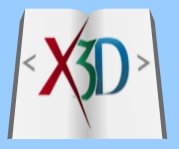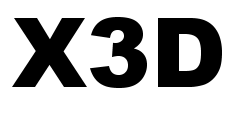Mouse-over the figure to see a larger version. Please allow a little time for the larger image to download.
Click on any of the figures to view a large version in a separate window.

Figure 1.1. Example software architecture for an X3D browser.
Figure 1.2. The family of X3D specifications includes multiple file encodings and programming-language bindings, all mapping to the same common functionality defined by the abstract specifications.
Figure 1.3. Multiple X3D profiles providing increasing sophistication allow more efficient browser support for lightweight content.- Image Not Available - Figure 01-04
Figure 1.4. Example meta tags in newScene. x3d. 
Figure 1.5. XML documents have a consistent tree structure for elements, attributes, and values.
Figure 1.6. Processing chain to start with any X3D content, apply geometric compression (if desired), add XML security features (if desired), and produce .x3db compressed binary encoding.
Figure 1.7. X3d-Edit is an XML-based Java application for creating and launching X3d scenes.
Portions of this work are from the book,
X3D: 3D Graphics for Web Authors, by
Don Brutzman and Leonard Daly, published by Morgan Kaufmann Publishers,
Copyright 2007 Elsevier, Inc. All rights reserved.
Web site copyright © 2008-2017, Daly Realism and Don Brutzman



